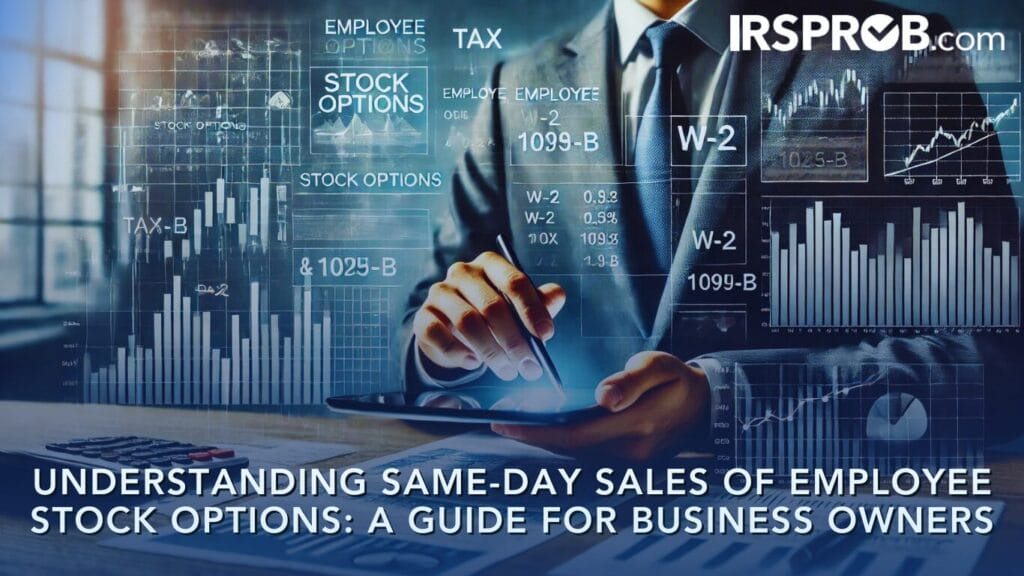
Employee stock options (ESOs) can be a powerful incentive for employees and a valuable tool for business owners. However, they come with complex tax implications that can trip up even the savviest entrepreneurs. One type of transaction business owners should understand is the same-day sale of employee stock options. Let’s break down how these sales work, their tax implications, and how to ensure your business and employees navigate these transactions smoothly.
What Are Employee Stock Options?
Employee stock options provide employees with the opportunity to purchase company stock at a predetermined price, often called the exercise price, within a specific timeframe. There are two types of stock options:
- Statutory Stock Options (Qualified): These include incentive stock options (ISOs) and options under an employee stock purchase plan (ESPP). These offer favorable tax treatment but come with specific holding period requirements.
- Nonstatutory Stock Options (Nonqualified): These do not meet the IRS requirements for favorable tax treatment but are more flexible. Any bargain element (the difference between the stock’s market value and exercise price) is taxed as wages when the option is exercised.
What Is a Same-Day Sale?
A same-day sale occurs when an employee exercises their stock option and sells the stock immediately. The employee does not need to pay for the stock upfront, but instead receives the cash difference between the exercise price and the stock’s market value.
For example, if an employee is granted the option to purchase $17,000 worth of stock, and the stock’s value is $25,000, the employee can sell the stock immediately in a same-day sale and pocket the $8,000 difference.
This transaction is taxed as ordinary income and must be reported as wages on the employee’s Form W-2. However, because of the immediate sale, the employee never actually holds the stock—this streamlines the transaction but complicates the tax reporting.
Tax Reporting of a Same-Day Sale
Same-day sales result in an unusual quirk in tax reporting, often causing confusion for both employees and business owners. The transaction is reported twice:
- W-2 Reporting: The bargain element (the difference between the exercise price and the market value) is included in the employee’s wages and reported in box 1 of Form W-2. The same amount is also reported in box 12 using code “V,” which denotes income from the exercise of nonqualified stock options.
- 1099-B Reporting: Since the transaction involves the sale of stock, it is also reported on Form 1099-B, which lists the total proceeds from the stock sale. Employees need to reconcile the income reported on their W-2 with the capital gains reported on Form 1099-B to avoid being taxed twice on the same income.
Without proper reporting, employees may receive a notice from the IRS for additional tax owed, often due to confusion between the W-2 wages and the stock sale proceeds.
How to Avoid Double Taxation
Business owners should ensure their employees understand how to properly report these transactions. Here’s a quick guide:
- Report the Income as Wages: The bargain element is included in the employee’s wages and does not need to be reported again as income on their tax return.
- Report the Sale on Form 8949: Proceeds from the sale must be reported on Form 8949, where employees can include the cost basis (exercise price plus income reported as wages) to offset the gain. In most cases, this will result in a small loss due to brokerage fees.
For example, if an employee receives $25,000 from a stock sale but had to pay $125 in brokerage fees, they would report the sale at a loss of $125 on Form 8949.
Key Considerations for Business Owners
- Education: Educate your employees about the tax implications of stock options, particularly same-day sales. Provide clear guidance or offer access to a tax advisor to help them navigate reporting.
- Timely Reporting: Ensure that all necessary information—especially the bargain element and proceeds from sales—is correctly reported on Forms W-2 and 1099-B. Any errors in reporting can lead to confusion and unexpected tax bills for your employees.
- Plan for Taxes: Since the bargain element is treated as wages, both the employee and the employer must pay payroll taxes on this income. Make sure your business has a plan in place for withholding and remitting the appropriate amount of tax.
Additional Insights: Capital Gains vs. Ordinary Income
One critical distinction in employee stock option taxation is whether the gain is treated as ordinary income or capital gain. Statutory stock options may offer capital gains treatment if the employee holds the stock for a certain period (generally more than one year). In contrast, nonstatutory stock options—especially with same-day sales—result in ordinary income, which is taxed at a higher rate than capital gains.
While offering stock options can incentivize employees and promote company growth, navigating the tax rules can be complicated. With the right preparation and a clear understanding of the tax implications, you can avoid costly mistakes and ensure that both your business and employees benefit from stock option programs.
Conclusion
Stock options are a valuable tool for attracting and retaining talent, but they come with complex tax implications that business owners must understand. Same-day sales, in particular, require careful attention to tax reporting to avoid penalties and double taxation. By staying informed and working closely with tax professionals, business owners can effectively manage their stock option programs and keep their employees satisfied with their financial outcomes.
For more information on stock option tax strategies or assistance with tax planning, reach out to IRSProb.com.








